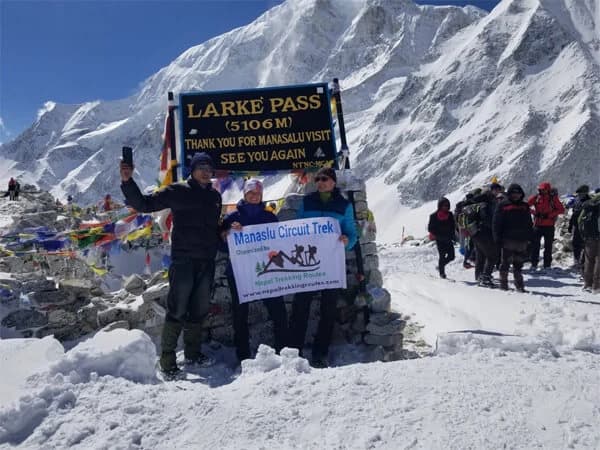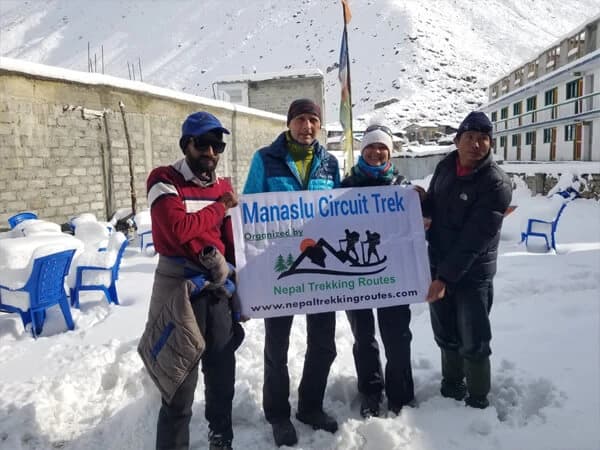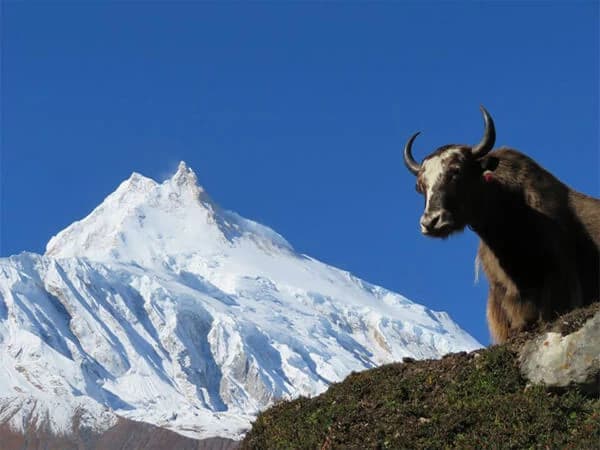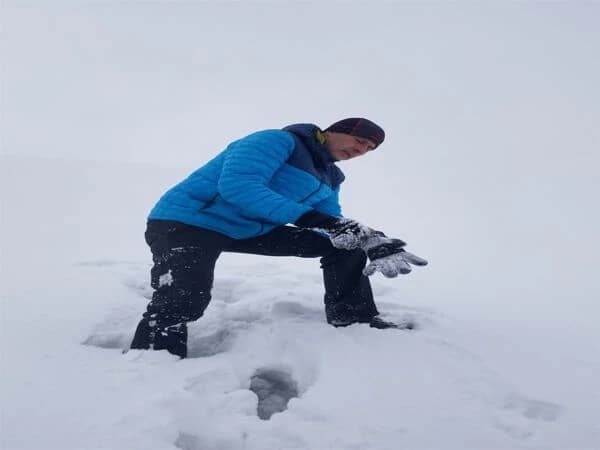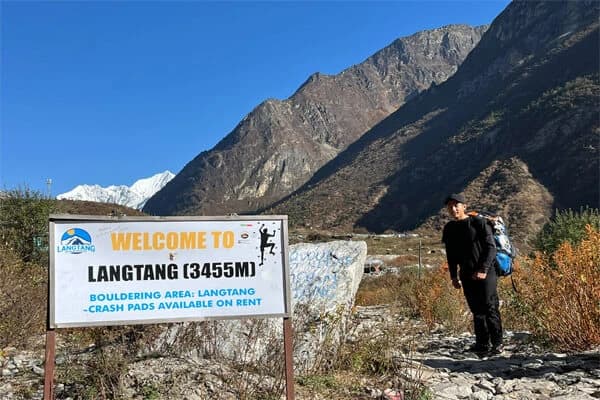The Manaslu Circuit Trek is a challenging adventure in the Manaslu region of Nepal. It takes you around the majestic Mount Manaslu, the eighth-highest mountain in the world. The stunning route of Manaslu Circuit is wedged between the Annapurnas and the Ganesh Himal. It is an ancient trail that passes through the Tibetan-influenced villages which were once used as salt-trading routes with Tibet.
The Manaslu circuit is a restricted area that requires multiple permits for trekking. It is an off-the-beaten-path journey with fewer trekkers than the other popular routes like Everest and Annapurna. The cultural identity and authenticity of the region are preserved from the modernization. With the cultural diversity of ethnic groups like the Nubri and Tsum people, you can experience the uniqueness of rural Nepal.
The trekkers can immerse themselves in natural beauty, terraced fields, stunning scenery, alpine forests, and panoramic views of Himalayan peaks. The rich biodiversity of the region offers a chance to explore the flora and fauna. The challenge and excitement of crossing high-altitude mountain passes like Larkya La Pass and reaching the base of Mount Manaslu provide a sense of achievement for adventure seekers.
Why Manaslu Circuit is a must-do trek
Manaslu Circuit is a must-do Nepal trekking because it offers a more adventurous and authentic experience compared to some commercialized routes. The remote nature of the trek provides a stronger connection with the pristine landscape and local culture of the region. You can experience the multi-culture and traditions with the lower sections of the trail inhabited by Brahman, Chhetri, Magar, Newar, and indigenous people. When you go higher up, you will encounter Gurungs as well as Tibetan-influenced culture.
The Manaslu Circuit trek offers breathtaking views of snowcapped peaks including Mt. Manaslu, Buddha Himal, Himal Chuli, Ganesh Himal, and many more. The trail includes a variety of terrain, from lush green sub-tropical forests to high alpine areas. The trail passes through the Manaslu Conservation Area which protects the wildlife and their habitat.
Here is why the Manaslu Circuit is a must-do trek:
- It is one of the remote treks that takes you to the base of the world’s 8th-highest peak, Mt. Manaslu.
- The trekking trail is off-the-beaten-path and a restricted region, so it is less crowded and peaceful.
- The trek passes through the traditional villages of Gurung and the Tibetan Buddhist community. It offers cultural immersion and warm hospitality.
- The trek lies in the Manaslu Conservation Area with a wide range of flora and fauna.
- The trail moves along the Budhi Gandaki River passing through green hills, serene valleys, and terraced farmlands.
- The trek offers spectacular vistas of snow-capped peaks including Himalchuli, Ngadi Chuli, Shringi, Langpo, and Saula.
- The incredible experience of crossing the high-altitude pass, Larkya La Pass (5,213m).
- The trek also offers opportunities for side trips to Manaslu Base Camp via Birendra Lake and Pungyen Gompa.
Manaslu Circuit Trek tips
The Manaslu Circuit Trek is a challenging journey through remote regions of Nepal. It is important to do a thorough preparation and planning. Proper preparation is essential to ensure both safety and an enjoyable experience on this high-altitude trek. Here are some of the best tips for Manaslu Circuit Trek:
Physical Readiness:
The trek involves long daily hikes, steep ascents, and descents, often at altitudes exceeding 5,000 meters. It is important to build stamina through cardiovascular exercises, strength training, and practice hikes. It can minimize fatigue and the risk of injury.
Acclimatization:
Altitude sickness is a significant concern on the trek. Planning for acclimatization days at Samagaon or Samdo is vital for adjusting to thinner air. It is important to recognize the symptoms of altitude sickness and respond promptly to stay safe.
Proper gear and Packing:
Harsh weather, especially in the high passes, requires suitable clothing and gear, such as layered clothing, sturdy trekking boots, and a good quality sleeping bag. It is important to pack light yet essential items like a first-aid kit, water purification tablets, and snacks.
Permits and Guide:
The trek lies in a restricted area that requires special permits and a licensed guide. Working with a reliable trekking agency like Nepal Trekking Routes simplifies this process. They will provide experienced guides who ensure safety and help navigate the terrain.
Weather and Timing:
The success of the trek depends on the choice of the right season. By choosing spring or autumn, you can avoid extreme cold or monsoon rains.
Proper preparation and planning enhance your trekking experience.
How to prepare for the Manaslu Circuit Trek
Preparing for the Manaslu Circuit Trek requires careful planning for a safe and enjoyable experience. Here is a breakdown of the key areas to focus on:
Physical fitness and training
You should be physically prepared for the multi-day hiking which includes 6-7 hours of daily walking. Start doing the exercises 2-3month before your trek.
- Cardiovascular Endurance: Do cardiovascular exercises regularly incorporating running, cycling, or swimming into your routine to build stamina for long trekking days.
- Strength Training: Focus on core and leg exercises like squats lunges, and planks to prepare for steep ascents and descents.
- Hiking Practice: Undertake shorter hikes with a loaded backpack to simulate trek conditions.
- Flexibility and Balance: Add yoga or stretching exercises to prevent injuries and improve stability on rugged terrain.
Necessary gear and equipment
Carrying the right gear and equipment is crucial for the Manaslu Circuit Trek due to its challenging and remote nature.
Ensuring safety:
The trek involves rugged trails, steep ascents, and descents. Proper trekking boots and poles improve stability and prevent injuries. Cold temperatures at higher altitudes require warm layers, gloves, and a quality sleeping bag to avoid hypothermia or frostbite.
Coping with Weather Conditions:
The region’s weather can be unpredictable with sudden rain or snow. Waterproof jackets, pants, and backpack covers keep you dry and comfortable. Sunglasses and sunscreen protect against the strong UV rays in snowy areas.
Supporting Physical Endurance:
Lightweight and quick-drying clothing prevents overheating and reduces fatigue. Energy snacks and water purification ensure you remain hydrated and nourished on long trekking days.
Comfort During Overnight stays
A warm sleeping bag rated for sub-zero temperatures ensures restful sleep in basic teahouses or camps. A headlamp and portable charger are essential for managing low-light conditions and keeping devices powered.

Navigating remote areas
Maps, GPS devices, or a guidebook help you stay on course in this less-commercialized region. A first-aid kit is vital for treating minor injuries or areas far from medical facilities.
Visa requirements and permits
Your passport should be valid for at least six months beyond your intended return date. Before your journey begins, check the visa requirements and arrange for the necessary documentation. You can either apply online visa before departure or get an on-arrival visa. Have cash and passport-sized photos ready.
The Manaslu Circuit trek lies in the Manaslu Conservation Area in the Gorkha district. It is a restricted area bordering the Tibetan region of China. Permits must be obtained through a registered trekking agency like Nepal Trekking routes and a licensed guide is mandatory. Solo trekkers are not allowed while a minimum group size of two people is required for the trek. Here are the permits required for the Manaslu Circuit Trek:
Manaslu Restricted Area Permit (RAP):
During the spring, summer and winter seasons, the RAP costs USD 75 per person. While, in autumn it costs USD 100 per person for 7 days. Additionally, each extra day costs USD 15 per person.
Manaslu Conservation Area Entry Permit (MCAP):
In addition to the RAP, trekkers need a Manaslu Conservation Area Entry Permit which costs USD 30. It can be obtained from the Nepal Tourism Board, Kathmandu, or at the entry points to the Manaslu Region.
Annapurna Conservation Area Permit (ACAP):
The Manaslu Circuit Trek often includes parts of the Annapurna region. Trekkers also need the Annapurna Conservation Area Permit which costs USD 30. It can be obtained from the Nepal Tourism Board Office in Kathmandu or at the entry points to the Annapurna region.
Trekkers Information Management System (TIMS):
- TIMS card can be obtained from Nepal Tourism Board Office in Kathmandu and costs USD 20.
- All permits will be arranged by the local trekking agency, Nepal Trekking Routes if you choose to trek with us.
Best time for Manaslu Circuit Trek
The weather conditions in the Manaslu Circuit region vary in different seasons. The best times to trek the Manaslu Circuit are during the pre-monsoon (spring) and post-monsoon (autumn) seasons.
Spring (March to May): Spring is one of the best time for the Manaslu Circuit trek. The weather is stable and the skies are clear. The visibility is excellent offering stunning views of the Himalayan Peaks. The temperature is mild and comfortable for trekking. The temperature in the lower altitudes ranges between 10°C-20°C and in the higher altitudes, it ranges between 5°C-15°C. The trails are adorned by blooming rhododendrons, adding shades of red, pink, and white to the landscape.
Autumn Season (September-November):Autumn is another best time for Manaslu Circuit Trek. The weather is stable and dry with fewer disruptions. The temperature is mild and comfortable. It ranges between 10°C-20°C in the lower section of the trail. In higher elevations, it ranges between 0°C-10°C.
The excellent visibility offers stunning views of the surrounding mountains.
Both of these seasons offer favorable weather conditions, making trekking more enjoyable. However, it is important to note that winter (December –February) and summer (June – August) are off-season for trekking in Nepal. The extreme cold, heavy snow, and harsh weather during winter are not suitable for trekking. Also, avoid trekking during the summer which brings monsoon rain, landslides, and leeches.
Acclimatization in Manaslu Circuit
Altitude sickness can affect anyone regardless of age, fitness level, or previous trekking experience. Altitude Sickness, also known as Acute Mountain sickness (AMS) is a health condition that occurs when someone is exposed to low levels of oxygen at higher altitudes. It is a life-threatening condition that needs to be dealt with immediately. The symptoms of AMS are headache, lack of appetite, breathing difficulty, nausea, vomiting and insomnia.
To prevent AMS, proper acclimatization and careful itinerary planning are critical. The Manaslu Circuit trek ascends to altitudes exceeding 5000 m, such as Larkya La Pass. At high-altitude, the air becomes thinner and the risk of AMS increases.
Best Acclimatization Tips for Manaslu Trek
Acclimatization is essential because gradual altitude gain allows your body to adapt to reduced oxygen levels. It minimizes the risk of AMS. If you ignore the symptoms of AMS, it can disrupt the trek and require evacuation. Thus, you must have acclimatization stops while gaining considerable altitude.
Key stops for Acclimatization:
Samagaon (3,520m): It is an ideal place for an acclimatization day. You can explore nearby attractions like the Manaslu Base Camp or Pungyen Gompa to help your body adapt while enjoying incredible views.
Samdo (3,875m): It is another recommended stop before the high-altitue push to Dharmashala and Larkya La Pass.
Manaslu trek Itinerary and route

A well-planned itinerary balances trekking distances, elevation gain, and rest days so that you can have a safer and more enjoyable journey. Here is a sample itinerary:
- Arrival in Kathmandu
- Drive from Kathmandu to Machhakhola
- Trek from Machhakhola to Jagat
- Trek to Deng
- Trek to Namrung
- Trek to Lho
- Trek to Samagaun
- Acclimatization Day at Samagaun
- Trek from Samagaun to Samdo
- Trek to Dharmashala
- Trek to Bimtang via Larkya La Pass
- Trek to Tilche
- Trek to Dharapani and drive to Kathmandu
- Final Departure
Trekking Essentials
The Manaslu Circuit Trek requires light and smart packing. Proper gear and warm clothing are essential for your trek.
Manaslu Circuit Packing list:
Clothing:
- 2 T-shirts
- Fleece/ soft-shell jacket
- Windproof/Waterproof Down Jacket
- Thermal layer
- Undergarments
- Trekking pants
- Gloves
- Woolen hats
Footwear:
- Trekking boots
- Socks
- Sandals
Accessories:
- Toiletries
- Sunscreen
- Sunhat
- Towel
Food and water:
- Trail mix
- Energy bar
- Snacks
- Water bottles and purification tablets
Essential Gear for Manaslu trekking
- Trekking poles
- Head torch
- Backpack
First aid kit and medical advice
The Manaslu Circuit Trek is remote and rugged. You should prepare a comprehensive first-aid kit and be aware of essential medical precautions. Access to medical facilities is limited, so you must be self-reliant.
Dietary needs and hydration tips
Proper nutrition and hydration are essential for maintaining energy, strength, and overall well-being during the trek. Here are some tips to manage your dietary needs and stay hydrated:
Dietary Needs
- High Calorie meals: Trekking burns a significant amount of energy. Choose meals rich in carbohydrates (rice, pasta, potatoes) and proteins (lentils, eggs, meat) to refuel your body. Traditional Nepali dal bhat and curry is an excellent option for a balanced combination of rice, lentils, and vegetables.
- Snacks for Energy: Take lightweight snacks like nuts, dried fruits or chocolates for sustained energy during long trekking days.
- Avoid heavy and greasy foods: Avoid eating heavy, oily or fried foods as they can be hard to digest.
- Cater to Dietary Restrictions: If you have specific dietary needs, inform your trekking agency in advance. Most teahouses accommodate vegetarian or vegan meals, but options may be limited in remote areas.
Hydration tips:
- Drink plenty of water: Aim to drink 3-4 liters of water daily to stay hydrated, especially in dry, high-altitude environments.
- Use safe water resources: Carry water purification tablets or portable filters, as bottle water is costly and contributes to plastic waste.
- Supplement with warm drinks: Teahouses offer hot drinks like tea or coffee, which are comforting and help with hydration.
- Avoid alcohol and caffeine: Alcohol dehydrates the body and can worsen altitude sickness symptoms. Moderate caffeine intake is acceptable but shouldn’t replace water consumption.
Manaslu Circuit Highlights
The Manaslu Circuit Trek is a once-in-a-lifetime experience for nature enthusiasts and adventurers. You will explore serene villages in the Himalayas and conquer the formidable Larkya La Pass. Here are the highlights of the trek:
Larkya La Pass (5,160 m)
Larkya La Pass is the highest point of the trek. The ascent is challenging, with steep inclines and unpredictable weather. The spectacular views from the Pass make it all worthwhile. It offers a 360-degree panoramic view of towering peaks like Himlung Himal, Cheo Himal, Kang Guru, and Annapurna II. The trek towards the pass requires endurance and reaching the summit is incredibly rewarding. The prayer flags fluttering in the wind symbolize blessings for all travelers.
Manaslu Base Camp (4,400 m):
Manaslu Base Camp is a side trip from Samagaun and a must-visit destination for trekkers. This iconic spot provides up-close views of the eighth-highest peak in the world, Mount Manaslu (8,163m). The base camp is surrounded by glaciers, rugged peaks, and the tranquil beauty of high-altitude landscapes. The journey to the base camp often passes through the yak pastures and traditional Buddhist chortens. These provide trekkers with a glimpse of local life.
Samagaon (3,520m):
Samagaun is one of the most significant and picturesque villages on the trek. This traditional village is nestled in a valley with stunning views of Mount Manaslu. Many trekkers spend a rest day here to acclimatize. The weary limbs can get some respite from the intense days on the trails. You can take a breather to relax or explore nearby attractions including Manaslu Base Camp or Pungyen Gompa. This village is home to ancient monasteries. It offers an opportunity to interact with the friendly local Tibetan-influence community. You can enjoy breathtaking views of the majestic mountains along with glaciers like Samdo, Nagdi chuli, Simnang himal, Manaslu glacier, and Manaslu icefall.
Bimthang (3,590 m):
Bimthang is a serene valley located just after the descent from Larkya La Pass. It is an ideal spot to relax and soak in the natural beauty. The exquisite view of Mount Manaslu makes every step worth it. The meadows, icy streams, and the views of the mountains are picture-perfect. The peaceful environment provides a sense of accomplishment after crossing the challenging Pass.
Nar Phu Valley:
Nar Phu Valley is slightly off the main Manaslu Circuit route. This is an extension that offers a raw and untouched Himalayan experience. The valley is home to ancient villages, Naar and Phu that have preserved their traditional Tibetan culture. Fewer trekkers venture into this area. It is a perfect trip for those seeking solitude and off-the-beaten-path adventures. The landscapes of this valley is dominated by narrow canyons, prayer flags, and medieval stone houses.
Ghyaru (3,673m) and Pisang(3,190 m):
Ghyaru and Pisang are located in the Annapurna region. These beautiful villages add charm to the extended Manaslu Circuit Trek. Ghyaru offers some of the best sunrise and sunset views of the Annapurna and Manaslu regions. It reflects the authentic Himalayan way of life, with centuries-old monasteries and terraced farmlands.
Pisang is known for its unique transition from lush green forests to arid landscapes as you approach the Annapurna region. Upper Pisang is adorned with a grand monastery that is worth exploring. Lower Pisang serves as a quaint resting point for trekkers.
Manaslu Trekking Challenges and Precautions

The Manaslu Circuit Trek brings beauty and adventure but also poses challenges. You should be prepared and informed about the difficulties. Taking precautions can make the trek safer and more enjoyable. Let us explore the major challenges and how to overcome them effectively.
High altitude sickness (AMS) prevention and treatment
- One of the most significant risks in high-altitude trekking is Acute Mountain Sickness (AMS). It occurs when the body struggles to adapt to reduced oxygen levels.
Symptoms of AMS:
Common symptoms of AMS include headaches, nausea, dizziness, shortness of breath, and fatigue. Severe cases may lead to serious conditions like High Altitude Pulmonary Edema (HAPE) or High Altitude Cerebral Edema (HACE).
Prevention:
- Ascend gradually, limiting altitude gain to 300-500 meters per day above 3,000 meters.
- Include acclimatization days into the itinerary, such as in villages like Samagaun during the Manaslu Circuit trek.
- Stay hydrated but avoid overhydrating, as it can dilute essential electrolytes.
- Avoid alcohol and caffeine, which can worsen the symptoms.
Treatment:
- Descend immediately if symptoms worsen.
- Rest and rehydrate at lower altitudes.
- Oxygen therapy or portable altitude chambers can provide temporary relief.
- Always trek with a guide, who can assist during emergencies.
Weather conditions and safety measures
Himalayan weather is notoriously unpredictable and poses challenges like extreme cold, snowfall, or rain. There can be snowstorms and avalanches in higher altitudes, especially near Larkya La Pass. Cold temperatures at night can drop well below freezing, even in spring or autumn. Monsoon rains can make trails slippery and cause landslides in lower altitudes.
Safety Measures
- Check the season: Spring (March-May) and autumn (September-November) offer the best weather conditions with clear skies and stable temperatures.
- Wear layered clothing to adapt to varying temperatures.
- Wear waterproof jackets and boots for rain and snow.
- Monitor weather reports to stay updated on forecasts and adjust plans if necessary.
- Seek shelter in teahouses or designated areas during severe weather.
Cultural sensitivity and respect for local customs
The villages along the Manaslu Circuit Trek have unique cultures, traditions, and spiritual beliefs. Respecting these is essential for maintaining harmonious interactions and preserving the heritage. Here are some tips:
- Dress modestly by covering your shoulders and legs when visiting monasteries or sacred sites.
- Follow local etiquette by removing shoes before entering homes or temples. Always walk clockwise around chortens and prayer wheels.
- Ask for permission before taking photos of people or religious places.
- Learn basic phrases in the local language like “Namaste” to maintain harmony.
- Be mindful of rituals by observing and respecting local customs during festivals or religious ceremonies.
Environmental impact and responsible trekking
The increasing popularity oftrekking in Nepalhas led to environmental concerns including trail degradation, deforestation, and pollution.
You should be responsible while trekking and follow these practices:
- Carry in Carry out by using a water bottle and purification tablets or filters to avoid plastic water bottles.
- Minimize waste by packing all non-biodegradable trash, including food wrappers and batteries.
- Stick to trails to avoid damaging vegetation.
- Respect wildlife by maintaining a safe distance and do not feed animals.
- Support sustainable practices by staying at lodges and eating where you stay.
How to trek Manaslu Circuit successfully
The Manaslu Circuit Trek can be a memorable experience with careful preparation. Here are some of the best tips for Manaslu Circuit Trek:
Cultural immersion and interaction with locals
The Manaslu Circuit Trek offers a unique opportunity to experience the rich culture of the region. The trail passes through remote villages, mostly populated by Gurungs and Tibetan-influenced people. Their lifestyles, traditions, and spiritual practices remain deeply rooted in their ancient cultures.
Cultural sites and Festivals:
The trek provides opportunities to visit monasteries like Pungyen Gompa and Ribung Gompa. These are the spiritual hubs for locals. You can observe and participate in rituals and festivals like Losar (Tibetan New Year), which enriches your trekking experience.
Interaction with Locals:
Trekkers are welcomed with warm hospitality in villages like Samagaun, Lho, and Namrung. The traditional stone houses and prayer flags make a unique landscape. You can engage with the locals and learn about their daily lives, farming practices, and Buddhist beliefs. You can share stories over a cup of local butter tea or tsampa and create meaningful connections. Trekkers can appreciate the resilience and spirituality of the communities living in the Himalayas through cultural immersion.
Photography tips for capturing the beauty of Manaslu
The Manaslu Circuit Trek is a photographer’s paradise. The pristine landscapes, snow-capped peaks, vibrant villages and serene monasteries provide great subjects for photography. Here are some tips to make the most of your photographic journey:
Leverage Natural Lighting:
Choose golden hours, shortly after sunrise and before sunset, for the best lighting. It offers soft, warm light perfect for capturing snow-clad peaks like Manaslu and Himlung. Cloud formations during these times add dramatic effects.
Emphasize Composition:
Use the “rule of thirds” to frame your shots. To add depth, include foreground elements like prayer flags, mani walls, or cascading rivers. Experiment with leading lines like trails or rivers to draw the viewer’s eye into the scene.
Capture Local Culture:
Photograph locals in traditional attire, festivals, or daily activities to highlight the trek’s cultural richness. Always ask for permission before taking portraits to ensure respectful interactions.
Prepare for Low Temperatures:
Cold weather can drain batteries quickly. Carry spares and keep them warm in your inner jacket pocket.
Wide-Angle and Telephoto Lenses:
A wide-angle lens is ideal for vast landscapes, while a telephoto lens is great for isolating distant peaks or capturing wildlife.
With thoughtful preparation and creativity, you can bring the magic of the Manaslu region to life through your photography.
Budgeting and spending tips
The Manaslu Circuit Trek can be affordable and enjoyable with proper budgeting.
Plan Ahead:
Research costs for flights, accommodations, packing lists, and gear. Book flights to Nepal early to get the best deals.
Choose Local Trekking Agencies:
Opt for reputable local agencies like Nepal Trekking Routes for cost-effective trekking packages. These often include permits, guides, porters, meals, and accommodation, reducing the risk of unexpected expenses.
Daily Expenses:
Budget $20-$30 per day for personal spending on snacks, drinks, and occasional upgrades in teahouses. Carry enough cash, as ATMs are unavailable along the trail.
Save on Gear:
Renting trekking gear in Kathmandu is a cost-effective alternative to buying expensive equipment. Make a checklist to avoid over-purchasing.
Meals and water:
Stick to local food options like dal bhat for nutritious and affordable meals. Use water purification tablets instead of buying bottled water, saving money and reducing waste. You can enjoy the trek without financial stress by planning and spending thoughtfully. Also, you will responsibly contribute to the local economy.
Post-trek activities and relaxation
After completing the challenging Manaslu Circuit trek, treat yourself to some well-deserved rest and rejuvenation. Nepal offers a variety of activities to help you unwind and celebrate your adventure.
Relax in Kathmandu:
Return to Kathmandu and enjoy the city’s comforts. Treat yourself to a relaxing massage or spa session in Thamel to soothe sore muscles. Indulge in various authentic cuisines, from Nepali dal bhat to international dishes, at one of the many cozy cafes or restaurants.
Sightseeing and Cultural Exploration:
Explore the UNESCO World Heritage Sites in Kathmandu Valley. Visit Swoyambhunath (Monkey Temple) for a panoramic view of the city, Pashupatinath Temple for its spiritual significance, and the ancient squares of Patan and Bhaktapur for their rich history and architecture.
Adventure Extension:
If you still crave adventure, consider a short trip to Chitwan National Park for a Chitwan jungle safari or to Pokhara for paragliding and lakeside relaxation.
Conclusion
The Manaslu Circuit trek is an incredible adventure in the Himalayas. You can enjoy the breathtaking views of snow-capped peaks, authentic cultural encounters, and the rich biodiversity of the region. Be mentally prepared, train for endurance, stay hydrated, acclimatize gradually, respect local customs, and hire experienced guides for a safe trek.
Embark on the Manaslu Circuit adventure with Nepal Trekking Routes. Their professional and friendly staff and guides will ensure your seamless and comfortable journey. Pack your bags, lace up your boots, and have an unforgettable adventure of a lifetime.





